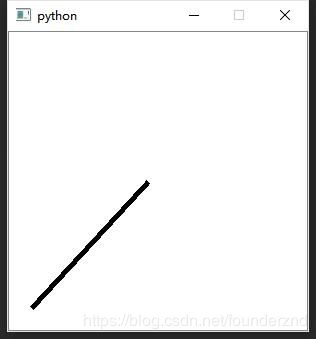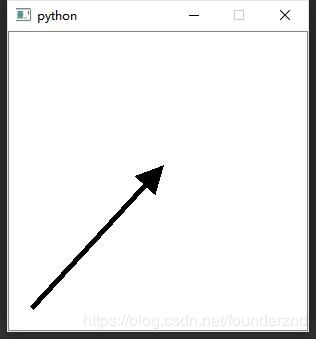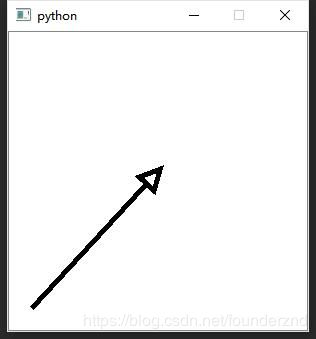Qt学习笔记#9:画一条带箭头的线
文章目录
- 前言
- 方法1:常规实现
- 1. 画一条没有箭头的线
- 2. 在这条线的基础上画上箭头
- 方法2:利用QPainterPath实现
- 总结
- 完整代码
前言
带箭头的线,在很多地方都会用到,以致于一开始我认为Qt会提供这样一个类。。。没想到的是Qt不仅没有提供相关的类,自己实现的时候还颇为复杂。。
其实我比较不理解。。为什么Qt不提供一个带箭头的线的类呢。。为什么为什么呢?这个应该不少人会用到吧。。。
废话不多说,马上开始。
方法1:常规实现
带箭头的线,简单来讲就是一条线加上一个三角形,我们可以通过自定义一个继承自QGraphicsLineItem的类,并重写他的paint()方法来实现:
1. 画一条没有箭头的线
class MyWidget(QGraphicsView):
def __init__(self):
super(MyWidget, self).__init__()
self.setFixedSize(300, 300)
self.setSceneRect(0, 0, 250, 250)
self.scene = QGraphicsScene()
self.setScene(self.scene)
self.scene.addItem(MyArrow())
class MyArrow(QGraphicsLineItem):
def __init__(self):
super(MyArrow, self).__init__()
self.source = QPointF(0, 250)
self.dest = QPointF(120, 120)
self.line = QLineF(self.source, self.dest)
self.line.setLength(self.line.length() - 20)
def paint(self, QPainter, QStyleOptionGraphicsItem, QWidget_widget=None):
# setPen
pen = QPen()
pen.setWidth(5)
pen.setJoinStyle(Qt.MiterJoin) #让箭头变尖
QPainter.setPen(pen)
# draw line
QPainter.drawLine(self.line)
if __name__ == '__main__':
import sys
app = QApplication(sys.argv)
w = MyWidget()
w.show()
sys.exit(app.exec_())
效果如图:
2. 在这条线的基础上画上箭头
首先利用QLineF().unitVector()函数得到它的单位向量,并将它移到原线的终点位置,注意这里的偏移量。
v = self.line.unitVector()
v.setLength(20) # 改变单位向量的大小,实际就是改变箭头长度
v.translate(QPointF(self.line.dx(), self.line.dy()))
这时候我们就得到这样一条线:
然后我们利用normalVector()函数得到他的法向量,然后再利用normalVector()得到法向量的反方向的向量。
n = v.normalVector() # 法向量
n.setLength(n.length() * 0.5) # 这里设定箭头的宽度
n2 = n.normalVector().normalVector() # 两次法向量运算以后,就得到一个反向的法向量
然后我们取得 3 个向量的终点 为箭头的三个端点,并以这三点为顶点画出三角形
p1 = v.p2()
p2 = n.p2()
p3 = n2.p2()
QPainter.drawPolygon(p1, p2, p3)
至此,箭头就算完成了!
如果你喜欢,你还可以填充箭头
brush = QBrush()
brush.setColor(Qt.black)
brush.setStyle(Qt.SolidPattern)
QPainter.setBrush(brush)
最后完成如下:
方法2:利用QPainterPath实现
QPainterPath其实是一个容器,他可以包含一个或者多个不同的绘画步骤,通过这些步骤组成较为复杂的图案,然后使用QPainter.drawPath()将这些图案一次性画出来。
实现的方式和普通方法的区别在于:
普通方法分两步画出图形,先画线,再画箭头
QPainter.drawLine(self.line)
QPainter.drawPolygon(p1, p2, p3)
而利用QPainterPath,则是先将整个绘制过程设置好,然后一次性画出整个path
arrow = QPolygonF([p1, p2, p3, p1])
path = QPainterPath()
path.moveTo(self.source) # 移动到线原点
path.lineTo(self.dest) # 添加线的路径
path.addPolygon(arrow) # 添加箭头路径
QPainter.drawPath(path) # 画出整个路径
总结
- 箭头相当于是这条线的额外部分,如果你对线的端点很敏感的话,要注意实际的长度 = 线原长 + 箭头的长度。
- 三角形算是最简单的图形了,并没有完全发挥QPainterPath的威力,事实上,你可以画朵花儿在线上。
完整代码
# coding:utf-8
from PyQt4.QtCore import *
from PyQt4.QtGui import *
class MyWidget(QGraphicsView):
def __init__(self):
super(MyWidget, self).__init__()
self.setFixedSize(300, 300)
self.setSceneRect(0, 0, 250, 250)
self.scene = QGraphicsScene()
self.setScene(self.scene)
self.scene.addItem(MyArrow())
class MyArrow(QGraphicsLineItem):
def __init__(self):
super(MyArrow, self).__init__()
self.source = QPointF(0, 250)
self.dest = QPointF(120, 120)
self.line = QLineF(self.source, self.dest)
self.line.setLength(self.line.length() - 20)
def paint(self, QPainter, QStyleOptionGraphicsItem, QWidget_widget=None):
# setPen
pen = QPen()
pen.setWidth(5)
pen.setJoinStyle(Qt.MiterJoin)
QPainter.setPen(pen)
# setBrush
brush = QBrush()
brush.setColor(Qt.black)
brush.setStyle(Qt.SolidPattern)
QPainter.setBrush(brush)
v = self.line.unitVector()
v.setLength(20)
v.translate(QPointF(self.line.dx(), self.line.dy()))
n = v.normalVector()
n.setLength(n.length() * 0.5)
n2 = n.normalVector().normalVector()
p1 = v.p2()
p2 = n.p2()
p3 = n2.p2()
# 方法1
QPainter.drawLine(self.line)
QPainter.drawPolygon(p1, p2, p3)
# 方法2
# arrow = QPolygonF([p1, p2, p3, p1])
# path = QPainterPath()
# path.moveTo(self.source)
# path.lineTo(self.dest)
# path.addPolygon(arrow)
# QPainter.drawPath(path)
if __name__ == '__main__':
import sys
app = QApplication(sys.argv)
w = MyWidget()
w.show()
sys.exit(app.exec_())





